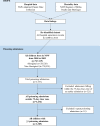Demographic and clinical characteristics of hospitalised unintentional poisoning in Aboriginal and non-Aboriginal preschool children in New South Wales, Australia: a population data linkage study
- PMID: 30705236
- PMCID: PMC6359875
- DOI: 10.1136/bmjopen-2018-022633
Demographic and clinical characteristics of hospitalised unintentional poisoning in Aboriginal and non-Aboriginal preschool children in New South Wales, Australia: a population data linkage study
Abstract
Objectives: To investigate differences in demographic and clinical characteristics of Aboriginal and non-Aboriginal children aged 0-4 years hospitalised for unintentional poisoning in New South Wales (NSW), Australia.
Design and setting: Retrospective whole-of-population cohort analysis of linked hospital and mortality data for 2000-2014.
Participants: All children (Aboriginal and non-Aboriginal) under the age of 5 years who were born in a hospital in NSW from 2000 to 2009.
Outcomes: The primary outcome was hospitalisation for unintentional poisoning. Logistic regression was used to estimate odds of poisoning hospitalisation for Aboriginal and non-Aboriginal children. Poisoning agents and clinical outcomes were compared by Aboriginality.
Results: The cohort included 767 119 children, including 28 528 (3.7%) Aboriginal children. Aboriginal children had approximately three times higher rates of hospitalised poisoning (1.34%) compared with non-Aboriginal children (0.41%). Poisoning incidence peaked at 2-3 years of age. Male sex, socioeconomic disadvantage and geographical remoteness were associated with higher odds of poisoning hospitalisation for Aboriginal and non-Aboriginal children, but associations with disadvantage and remoteness were statistically significant only for non-Aboriginal children. Most (83%) poisonings were caused by pharmaceutical agents. Few Aboriginal and non-Aboriginal children had repeat admissions for poisoning; most had a length of stay of 1 day or less. Only 8% of poisoning admissions involved contact with a social worker.
Conclusion: Commonly used medications in the general population contribute to poisonings among both Aboriginal and non-Aboriginal preschool-aged children. This study highlights a need to develop culturally safe poisoning prevention strategies and policies.
Keywords: aboriginal; child, preschool; data linkage; poisoning; unintentional injury.
© Author(s) (or their employer(s)) 2019. Re-use permitted under CC BY-NC. No commercial re-use. See rights and permissions. Published by BMJ.
Conflict of interest statement
Competing interests: None declared.
Figures


References
-
- World Health Organization. World report on child injury prevention. Switzerland: World Health Organization, 2008. 9241563575. - PubMed
-
- Cripps R, Steel D. Childhood poisoning in Australia. South Australia: AIHW National Injury Surveillance Unit, Flinders University, 2006.
-
- Tovell A, McKenna K, Bradley C, et al. . Hospital separations due to injury and poisoning, Australia 2009–10. Canberra: Australian Institute of Health and Welfare, 2012. Cat. no. INJCAT 145.
Publication types
MeSH terms
LinkOut - more resources
Full Text Sources
Medical
Molecular Biology Databases
